(完整)人教版七年级英语时态语法讲解
- 格式:doc
- 大小:51.52 KB
- 文档页数:7
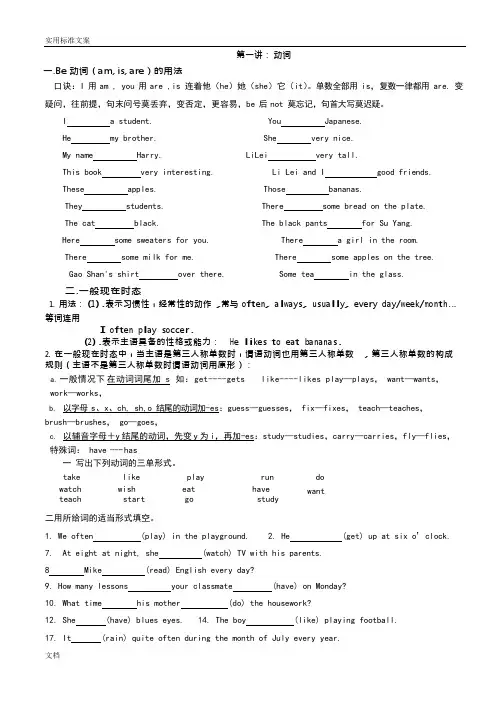
第一讲:动词一.Be 动词(am, is, are)的用法口诀:I 用 am , you 用 are ,is 连着他(he)她(she)它(it)。
单数全部用 is,复数一律都用 are. 变疑问,往前提,句末问号莫丢弃,变否定,更容易,be 后 not 莫忘记,句首大写莫迟疑。
I a student. You Japanese.He my brother. She very nice.My name Harry. LiLei very tall.This book very interesting. Li Lei and I good friends.These apples. Those bananas.They students. There some bread on the plate.The cat black. The black pants for Su Yang.Here some sweaters for you. There a girl in the room.There some milk for me. There some apples on the tree.Gao Shan's shirt over there. Some tea in the glass.二.一般现在时态1.用法:(1).表示习惯性,经常性的动作,常与o f t e n,a l w a y s,u s u a ll y,e v e r y d a y/w ee k/m o n t h…等词连用I o f t e n p l a y s o cc e r.(2).表示主语具备的性格或能力:H e li k e s t o e a t b a n a n a s.2.在一般现在时态中,当主语是第三人称单数时,谓语动词也用第三人称单数, 第三人称单数的构成规则(主语不是第三人称单数时谓语动词用原形):a.一般情况下在动词词尾加 s 如:get----gets like----likes play—plays, want—wants,work—works,b.以字母 s、x、ch, sh,o 结尾的动词加-es:guess—guesses, fix—fixes, teach—teaches,brush—brushes, go—goes,c.以辅音字母+y 结尾的动词,先变y 为i,再加-es:study—studies,carry—carries,fly—flies,特殊词: have --- has一写出下列动词的三单形式。
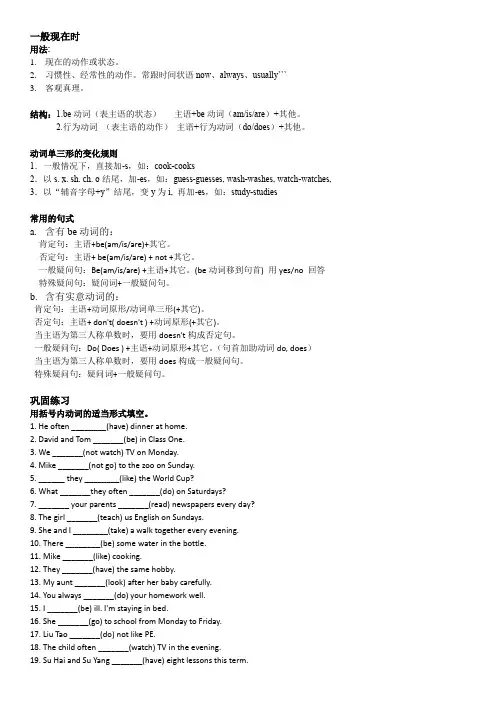
一般现在时用法:1.现在的动作或状态。
2.习惯性、经常性的动作。
常跟时间状语now、always、usually```3.客观真理。
结构:1.be动词(表主语的状态)主语+be动词(am/is/are)+其他。
2.行为动词(表主语的动作)主语+行为动词(do/does)+其他。
动词单三形的变化规则1.一般情况下,直接加-s,如:cook-cooks2.以s. x. sh. ch. o结尾,加-es,如:guess-guesses, wash-washes, watch-watches, 3.以“辅音字母+y”结尾,变y为i, 再加-es,如:study-studies常用的句式a.含有be动词的:肯定句:主语+be(am/is/are)+其它。
否定句:主语+ be(am/is/are) + not +其它。
一般疑问句:Be(am/is/are) +主语+其它。
(be动词移到句首)用yes/no 回答特殊疑问句:疑问词+一般疑问句。
b.含有实意动词的:肯定句:主语+动词原形/动词单三形(+其它)。
否定句:主语+ don't( doesn't ) +动词原形(+其它)。
当主语为第三人称单数时,要用doesn't构成否定句。
一般疑问句:Do( Does ) +主语+动词原形+其它。
(句首加助动词do, does)当主语为第三人称单数时,要用does构成一般疑问句。
特殊疑问句:疑问词+一般疑问句。
巩固练习用括号内动词的适当形式填空。
1. He often ________(have) dinner at home.2. David and Tom _______(be) in Class One.3. We _______(not watch) TV on Monday.4. Mike _______(not go) to the zoo on Sunday.5. ______ they ________(like) the World Cup?6. What _______they often _______(do) on Saturdays?7. _______ your parents _______(read) newspapers every day?8. The girl _______(teach) us English on Sundays.9. She and I ________(take) a walk together every evening.10. There ________(be) some water in the bottle.11. Mike _______(like) cooking.12. They _______(have) the same hobby.13. My aunt _______(look) after her baby carefully.14. You always _______(do) your homework well.15. I _______(be) ill. I'm staying in bed.16. She _______(go) to school from Monday to Friday.17. Liu Tao _______(do) not like PE.18. The child often _______(watch) TV in the evening.19. Su Hai and Su Yang _______(have) eight lessons this term.20. -What day _______(be) it today?-It’s Saturday.按照要求改写句子1. David watches TV every evening.(改为否定句)___________________________________________________2. I do my homework every day.(改为一般疑问句,作否定回答)____________________________________________________________________________________3. She likes milk.(改为一般疑问句,作肯定回答)___________________________________________________________________________________4. Helen likes playing computer games.(改为一般疑问句,作否定回答) ____________________________________________________________________________________________5. We go to school every morning.(改为否定句)_______________________________________________________6. He speaks English very well.(改为否定句)___________________________________________________7. I like taking photos in the park.(对划线部分提问)________________________________________________________ 8. Jim comes from Canada.(对划线部分提问)___________________________________________________9. She is always a good student.(改为一般疑问句,作否定回答)________________________________________________________________________________________10. Tom and David like going skating.(改为否定句)___________________________________________________现在进行时用法:(句中一般含有now, look, 现在正在进行或发生的动作,也可表示当前一段时间内的活动或现阶段正在进行的动作。

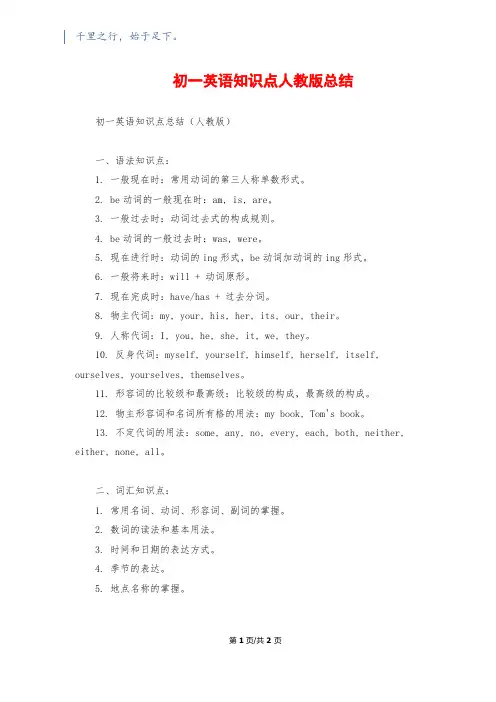
千里之行,始于足下。
初一英语知识点人教版总结初一英语知识点总结(人教版)一、语法知识点:1. 一般现在时:常用动词的第三人称单数形式。
2. be动词的一般现在时:am, is, are。
3. 一般过去时:动词过去式的构成规则。
4. be动词的一般过去时:was, were。
5. 现在进行时:动词的ing形式,be动词加动词的ing形式。
6. 一般将来时:will + 动词原形。
7. 现在完成时:have/has + 过去分词。
8. 物主代词:my, your, his, her, its, our, their。
9. 人称代词:I, you, he, she, it, we, they。
10. 反身代词:myself, yourself, himself, herself, itself, ourselves, yourselves, themselves。
11. 形容词的比较级和最高级:比较级的构成,最高级的构成。
12. 物主形容词和名词所有格的用法:my book, Tom's book。
13. 不定代词的用法:some, any, no, every, each, both, neither, either, none, all。
二、词汇知识点:1. 常用名词、动词、形容词、副词的掌握。
2. 数词的读法和基本用法。
3. 时间和日期的表达方式。
4. 季节的表达。
5. 地点名称的掌握。
第1页/共2页锲而不舍,金石可镂。
三、句型知识点:1. 陈述句的基本句型:主语+谓语+宾语。
2. 疑问句的基本句型:助动词/系动词/情态动词+主语+动词?3. 否定句的基本句型:主语+助动词/be动词/情态动词+not+动词原形。
4. be动词的疑问句和否定句的构成。
5. 以What/Who/Where/When/How开头的特殊疑问句的构成。
四、阅读技巧和写作要点:1. 阅读理解题的解题技巧。
2. 写作要点:选择合适的词汇和句型,注意语法和拼写错误,组织结构和内容的连贯性。
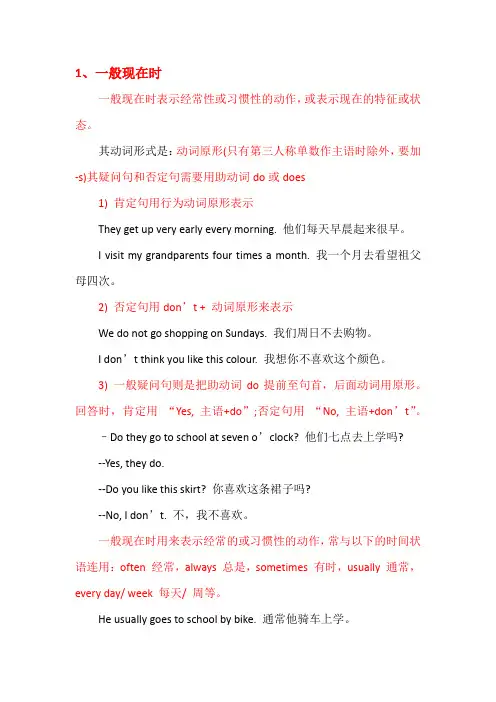
1、一般现在时一般现在时表示经常性或习惯性的动作,或表示现在的特征或状态。
其动词形式是:动词原形(只有第三人称单数作主语时除外,要加-s)其疑问句和否定句需要用助动词do或does1) 肯定句用行为动词原形表示They get up very early every morning. 他们每天早晨起来很早。
I visit my grandparents four times a month. 我一个月去看望祖父母四次。
2) 否定句用don’t + 动词原形来表示We do not go shopping on Sundays. 我们周日不去购物。
I don’t think you like this colour. 我想你不喜欢这个颜色。
3) 一般疑问句则是把助动词do提前至句首,后面动词用原形。
回答时,肯定用“Yes, 主语+do”;否定句用“No, 主语+don’t”。
–Do they go to school at seven o’clock? 他们七点去上学吗?--Yes, they do.--Do you like this skirt? 你喜欢这条裙子吗?--No, I don’t. 不,我不喜欢。
一般现在时用来表示经常的或习惯性的动作,常与以下的时间状语连用:often 经常,always 总是,sometimes 有时,usually 通常,every day/ week 每天/ 周等。
He usually goes to school by bike. 通常他骑车上学。
I visit my grandparents every week. 我每个星期都去看祖父母。
She is always late for class. 她总是上课迟到。
My parents and I sometimes go out to eat. 我和父母有时出去吃饭。
It often rains here. 这儿常常下雨。
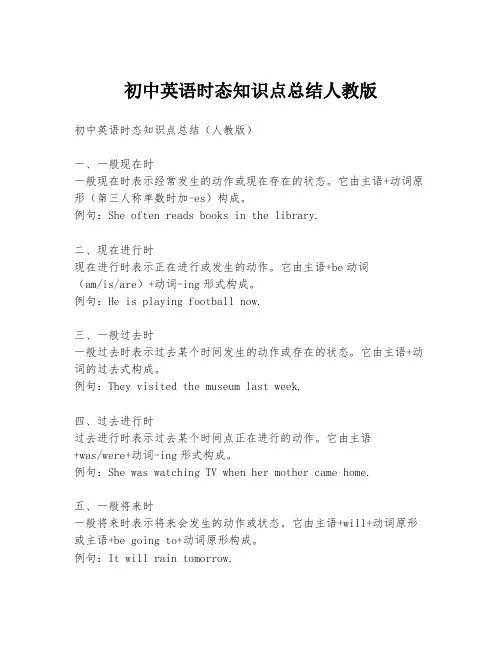
初中英语时态知识点总结人教版初中英语时态知识点总结(人教版)一、一般现在时一般现在时表示经常发生的动作或现在存在的状态。
它由主语+动词原形(第三人称单数时加-es)构成。
例句:She often reads books in the library.二、现在进行时现在进行时表示正在进行或发生的动作。
它由主语+be动词(am/is/are)+动词-ing形式构成。
例句:He is playing football now.三、一般过去时一般过去时表示过去某个时间发生的动作或存在的状态。
它由主语+动词的过去式构成。
例句:They visited the museum last week.四、过去进行时过去进行时表示过去某个时间点正在进行的动作。
它由主语+was/were+动词-ing形式构成。
例句:She was watching TV when her mother came home.五、一般将来时一般将来时表示将来会发生的动作或状态。
它由主语+will+动词原形或主语+be going to+动词原形构成。
例句:It will rain tomorrow.六、将来进行时将来进行时表示将来某个时间点正在进行的动作。
它由主语+will be+动词-ing形式构成。
例句:He will be working at this time tomorrow.七、现在完成时现在完成时表示过去发生的动作对现在造成的影响或结果,或者是从过去开始一直持续到现在的动作。
它由主语+have/has+动词的过去分词构成。
例句:I have finished my homework.八、现在完成进行时现在完成进行时表示从过去某一时间开始,一直持续到现在并可能继续下去的动作。
它由主语+have/has been+动词-ing形式构成。
例句:She has been studying English for five years.九、过去完成时过去完成时表示在过去某个时间点之前已经完成的动作。
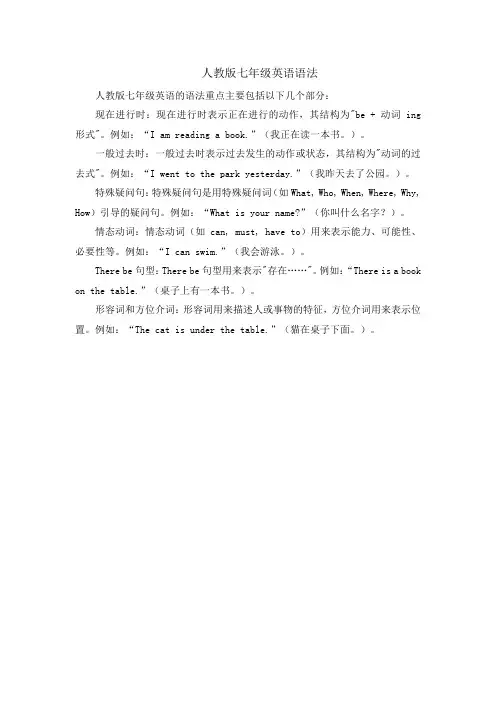
人教版七年级英语语法
人教版七年级英语的语法重点主要包括以下几个部分:
现在进行时:现在进行时表示正在进行的动作,其结构为"be + 动词ing 形式"。
例如:“I am reading a book.”(我正在读一本书。
)。
一般过去时:一般过去时表示过去发生的动作或状态,其结构为"动词的过去式"。
例如:“I went to the park yesterday.”(我昨天去了公园。
)。
特殊疑问句:特殊疑问句是用特殊疑问词(如What, Who, When, Where, Why, How)引导的疑问句。
例如:“What is your name?”(你叫什么名字?)。
情态动词:情态动词(如can, must, have to)用来表示能力、可能性、必要性等。
例如:“I can swim.”(我会游泳。
)。
There be句型:There be句型用来表示"存在……"。
例如:“There is a book on the table.”(桌子上有一本书。
)。
形容词和方位介词:形容词用来描述人或事物的特征,方位介词用来表示位置。
例如:“The cat is under the table.”(猫在桌子下面。
)。
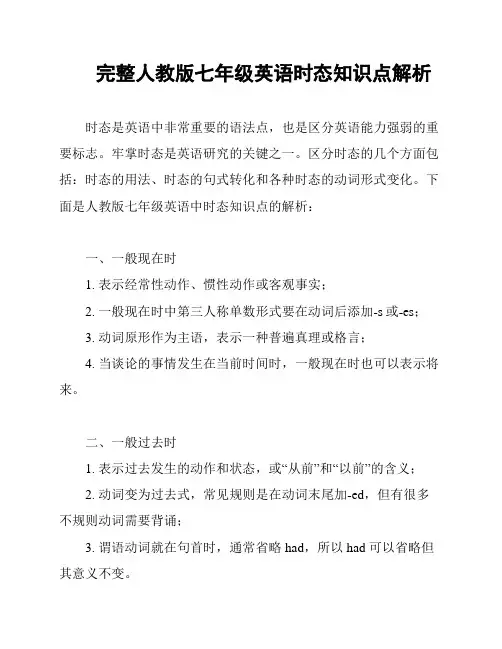
完整人教版七年级英语时态知识点解析时态是英语中非常重要的语法点,也是区分英语能力强弱的重要标志。
牢掌时态是英语研究的关键之一。
区分时态的几个方面包括:时态的用法、时态的句式转化和各种时态的动词形式变化。
下面是人教版七年级英语中时态知识点的解析:一、一般现在时1. 表示经常性动作、惯性动作或客观事实;2. 一般现在时中第三人称单数形式要在动词后添加-s或-es;3. 动词原形作为主语,表示一种普遍真理或格言;4. 当谈论的事情发生在当前时间时,一般现在时也可以表示将来。
二、一般过去时1. 表示过去发生的动作和状态,或“从前”和“以前”的含义;2. 动词变为过去式,常见规则是在动词末尾加-ed,但有很多不规则动词需要背诵;3. 谓语动词就在句首时,通常省略 had,所以 had 可以省略但其意义不变。
三、一般将来时1. 表示将来的动作或存在的状态,意义上相当于“将要”;2. 一般将来时通常要用助动词will(shall),用于第一人称时,也可以使用 shall;3. “be going to+动词原形”也是表示将来的另一种方式。
四、现在进行时1. 表示现在正在进行或发生的动作;2. 由“be +现在分区”构成,be 动词的形式与主语一致,现在分词则在动词原形后添加-ing;3. 时间状语:now,at present,right now 等,用于强调正在发生的动作。
五、过去进行时1. 表示过去某一时刻正在进行的动作;2. 由“was / were+现在分词”构成,was / were 动词的形式与主语一致,现在分词则在动词原形后添加-ing;3. 时间状语:at that time,at six o’clock yesterday evening 等。
六、将来进行时1. 表示“将来某一时刻正在进行的动作”;2. 由“will be +现在分词”构成;3. 这种时态比较少见,常被其他时态所替代。
七、现在完成时1. 表示过去某个不确定的时间开始,持续到现在还未结束的动作;2. 由“have / has +过去分词”构成,have 和 has 用于不同的人称,动词的过去分词形式在常规情况下为动词原形+ed,但也有很多特殊情况需要特别记忆。
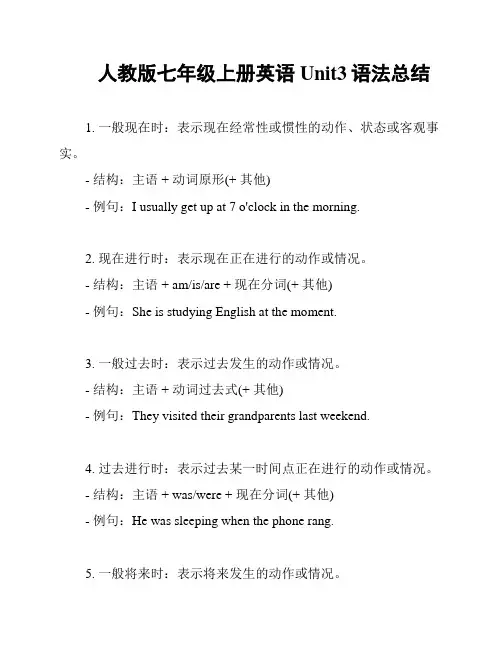
人教版七年级上册英语Unit3语法总结1. 一般现在时:表示现在经常性或惯性的动作、状态或客观事实。
- 结构:主语 + 动词原形(+ 其他)- 例句:I usually get up at 7 o'clock in the morning.2. 现在进行时:表示现在正在进行的动作或情况。
- 结构:主语 + am/is/are + 现在分词(+ 其他)- 例句:She is studying English at the moment.3. 一般过去时:表示过去发生的动作或情况。
- 结构:主语 + 动词过去式(+ 其他)- 例句:They visited their grandparents last weekend.4. 过去进行时:表示过去某一时间点正在进行的动作或情况。
- 结构:主语 + was/were + 现在分词(+ 其他)- 例句:He was sleeping when the phone rang.5. 一般将来时:表示将来发生的动作或情况。
- 结构:主语 + will + 动词原形(+ 其他)- 例句:I will go to the park tomorrow.6. 能力和意愿:can,could,may,might,must,shall,should,would等。
- 例句:You should finish your homework before going out.7. 祈使句:表示命令、请求、建议、劝告或禁止等。
- 结构:动词原形(+ 其他)- 例句:Please pass me the book.8. 直接引语和间接引语:表示他人的陈述、断言或问句等。
- 结构:直接引语:引号内的内容;间接引语:引号外的内容。
- 例句:- 直接引语:He said, "I am studying English."- 间接引语:He said that he was studying English.以上是人教版七年级上册英语Unit3语法总结,供参考。
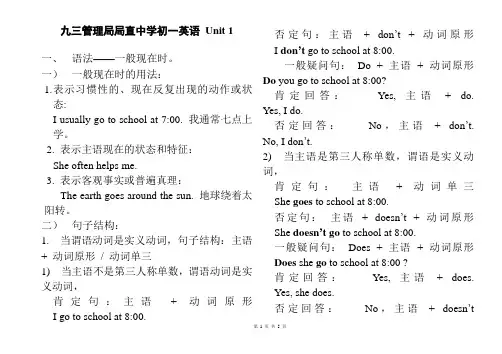
九三管理局局直中学初一英语Unit 1一、语法——一般现在时。
一)一般现在时的用法:1.表示习惯性的、现在反复出现的动作或状态:I usually go to school at 7:00. 我通常七点上学。
2. 表示主语现在的状态和特征:She often helps me.3. 表示客观事实或普遍真理:The earth goes around the sun. 地球绕着太阳转。
二)句子结构:1. 当谓语动词是实义动词,句子结构:主语+ 动词原形/ 动词单三1) 当主语不是第三人称单数,谓语动词是实义动词,肯定句:主语+ 动词原形I go to school at 8:00.否定句:主语+ don’t+ 动词原形I don’t go to school at 8:00.一般疑问句:Do + 主语+ 动词原形Do you go to school at 8:00?肯定回答:Yes, 主语+ do. Yes, I do.否定回答:No,主语+ don’t. No, I don’t.2) 当主语是第三人称单数,谓语是实义动词,肯定句:主语+ 动词单三She goes to school at 8:00.否定句:主语+ doesn’t + 动词原形She doesn’t go to school at 8:00.一般疑问句:Does + 主语+ 动词原形Does she go to school at 8:00 ?肯定回答:Yes, 主语+ does.Yes, she does.否定回答:No,主语+ doesn’tNo, she doesn’t.3)动词第三人称单数的变化规则:a. 一般情况下,在词尾加-s:play- plays get- gets.b. 以s,x,sh,ch结尾的动词,在词尾加-es:watch- watches go- goes.c. 以辅音字母加y结尾的动词,要把y变成i,再加-es:fly- flies study- studies2. 当谓语动词是be动词,句子结构:主语+ be 的适当形式1) 肯定句:主语+ be (am / is are)I am an English teacher.否定句:主语+ be (m / is are)+ notI am not an English teacher.一般疑问句:Be(Is/ Are) + 主语Are you an English teacher?肯定回答:Yes, 主语+ be(am/ is/ are). Yes, I am.否定回答:No,主语+ don’t. No, I am not.2)be动词的使用口诀:我用am,你用are,is连着他她塔,单数is 复数are。

初一英语考试必考四种基本时态详解1一般现在时一般现在时的用法1)经常性或习惯性的动作,常与表示频腮度的时间状语连用。
时间状语:every…, sometimes, at…, on Sunday。
例如:I leave home for school at 7 every morning. 每天早上我七点离开家。
2)客观真理,客观存在,科学事实。
例如:The earth moves around the sun. 地球绕太阳转动。
Shanghai lies in the east of China. 上海位于中国东部。
3)表示格言或警句。
例如:Pride goes before a fall. 骄者必败。
注意:此用法如果出现在宾语从句中,即使主句是过去时,从句谓语也要用一般现在时。
例:Columbus proved that the earth is round. 哥伦布证实了地球是圆的。
4)现在时刻的状态、能力、性格、个性。
例如 I don't want so much. 我不要那么多。
Ann writes good English but doesnot speak well. 安英语写得不错,讲的可不行。
练习:1. We often______(play) in the playgound.2. He _____(get) up at six o’clock.3. _____you ______(brush) your teeth every morning.What (do) ______he usually (do)______ after school?5. Danny _____(study) English, Chinese, Maths, Science and Art an school.6. Mike sometimes ________(go) to the park with his sister.7. At eight at night, she __________(watch) TV with his parents.8. ________ Mike________(read) English every day?9. How many lessons_________your classmate________(have) on Monday?10. What time_________his mother_________(do) the housework?改句子1. Do you often play football after school? (肯定回答)2. Gao Shan’s sister likes playing table tennis (改为否定句)3. She lives in a small town near New York. (改为一般疑问句)4. We have four lessons.(否定句)5. Nancy doesn’t run fast (肯定句)6. Mike has two letters for him.一般疑问句:否定句:7. I usually play football on Friday afternoon.否定句:一般疑问句:2一般过去时一般过去时的基本用法:1.通常表示过去发生的而现在已经结束的事件、动作或情况。
2024人教版七年级英语一、语法知识。
1. 一般现在时。
- 用法:- 表示经常或习惯性的动作或状态。
例如:I often get up at six o'clock.(我经常六点起床。
)- 表示客观事实或真理。
例如:The earth goes around the sun.(地球绕着太阳转。
)- 句子结构:- 肯定句:主语+动词原形(第三人称单数主语+动词第三人称单数形式)。
如:He likes reading books.(他喜欢读书。
)- 否定句:主语+don't/doesn't+动词原形。
如:I don't like math.(我不喜欢数学。
)- 一般疑问句:Do/Does+主语+动词原形?如:Does she go to school by bike?(她骑自行车去上学吗?)2. 名词的复数形式。
- 规则变化:- 一般在名词后加 -s。
如:book - books,pen - pens。
- 以s,x,sh,ch结尾的名词加 -es。
如:box - boxes,bus - buses。
- 以辅音字母+y结尾的名词,变y为i加 -es。
如:baby - babies。
- 以o结尾的名词,有生命的加 -es(如:potato - potatoes,tomato - tomatoes),无生命的加 -s(如:photo - photos)。
- 不规则变化:- 例如:man - men,woman - women,child - children,foot - feet,tooth - teeth等。
3. 形容词性物主代词。
- 包括:my(我的),your(你的/你们的),his(他的),her(她的),its (它的),our(我们的),their(他们的)。
- 用法:用来修饰名词,表示所属关系。
例如:This is my book.(这是我的书。
)二、词汇积累。
人教版七年级英语时态总结人教版七年级英语时态总结如下:1、一般现在时(1)构成:主语+be动词(am/is/are)+其他。
(2)用法:表示现在经常发生的动作或存在的状态。
例句:He is a student. 他是一个学生。
2、现在进行时(1)构成:主语+be动词(am/is/are)+动词-ing形式。
(2)用法:表示现在正在进行的动作或存在的状态。
例句:He is listening to the music now.他现在正在听音乐。
3、现在完成时(1)构成:主语+have/has+动词的过去分词。
(2)用法:表示过去发生的动作对现在造成的影响或结果。
例句:I bought a new house, but I haven't sold my old one yet, so at the moment I have two houses.我买了一所新房子,但是还没有卖掉旧的,所以现在我又两所房子。
4、现在完成进行时(1)构成:主语+have/has+been+动词的ing形式。
(2)用法:表示从过去某一时刻开始一直延续到现在的动作或状态,强调这个动作可能会继续下去。
例句:We have been working on this project for over a month now.到目前为止,我们一直在处理那个项目,已经花了一个多月时间了。
5、一般过去时(1)构成:主语+动词的过去式。
(2)用法:表示过去某个时间发生的动作或存在的状态。
例句:I bought some fruits yesterday.我昨天买了一些水果。
6、过去进行时(1)构成:主语+was/were+动词-ing形式。
(2)用法:表示过去某个时间正在进行的动作或存在的状态。
例句:I was travelling in London last summer vacation.去年暑假我在伦敦旅行。
7、过去完成时(1)构成:主语+had+动词的过去分词。
完整人教版七年级英语时态语法讲解七年级英语语法——时态讲解及练时态定义:表示经常、反复发生的动作、经常存在的状态或者惯性动作(有时间规律发生的事情)的一种时间状态。
具体用法:1.表示经常的或惯性的动作,常与表示频率的时间状语连用(always。
usually。
often。
sometimes。
everyday。
morning。
night。
evening。
afternoon。
week)。
例如:I go to school at 8 every morning.2.表示主语具备的性格、水平、特征和状态及喜好等。
例如:She is 11 years old。
I don’t like English。
She can speak English well.3.表示客观事实和普遍真理。
例如:XXX around the sun.基本结构构成:含有be(am、is、are)动词的用法:肯定句:I am + 其它,You/they/we are + 其它,She/he/it is + 其它。
否定句:I am not + 其它,You/they/we are not + 其它,She/he/it is not + 其它。
一般疑问句及回答:Are you + 其它?肯定回答:Yes。
I am。
否定回答:No。
I am not。
Are you/they/you + 其它?肯定回答:Yes。
we/they are。
否定回答:No。
we/they are not。
Is she/he/it + 其它?肯定回答:Yes。
she/he/it is。
否定回答:No。
she/he/it is not。
从上面结构中你能总结出be动词的用法吗?单数用is,复数用are;我用am,你用are,连着她他它用is。
含实义动词的结构:肯定句:主语(I。
we。
you。
they)+动词原形+其它。
否定句:主语(I。
we。
you。
they)+don’t+动原+其它。
人教部编版初中英语16个时态全面详解1.一般现在时(do/does; is/am/are)①表示现在的情况、状态或特征。
例:He is a student.他是一个学生。
②表示经常性、习惯性动作。
例:He always helps others.他总是帮助别人。
③客观事实和普遍真理。
例:The earth moves the sun.地球绕着太阳转。
④表示一个按规定、计划或安排要发生的动作。
仅限于某些表示“来、去、动、停、开始、结束、继续”等的动词,可以与表示未来时间的状语搭配使用。
常见的用法是:飞机、火车、轮船、汽车等定期定点运行的交通方式。
例:The next train leaves at 3 o'clock this afternoon.下一趟火车今天下午3点开车。
⑤在时间、条件和让步状语从句中经常用一般现在(有时也用现在完成时)表示将的来事情。
(即:主将从现原则)例:I will call you as soon as I arrive at the airport.我一到机场就会给你打电话。
When you have finished the report, I will have waited for about 3 hours.等你完成这份报告的时候,我就已经等了将近3个小时了。
2. 现在进行时(am/is/are doing)①表示此时此刻正在发生的事情。
例:He is listning to the music now.他现在正在听音乐。
②表示目前一段时间内一直在做的事情,但不一定此时此刻正在做。
例:I am studying computer this term.这个学期我一直在学习计算机。
③现在进行时可以表示将来的含义。
瞬时动词的进行一定表将来。
例:I am leaving.我要离开了。
持续动词的进行只有有将来的时间状语或有将来语境中才表将来。
例:I am travelling next month.下个月我要去旅行。
七年级英语语法 ----时态讲解及其练习一、一般现在时定义:表示经常、反复发生的动作,经常存在的状态或者习惯性动作〔有时间规律发生的事情〕的一种时间状态。
〔很拗口,但要学会就必须深刻体会, so please 将其狂读 3 遍〕具体用法1、表示经常的或习惯性的动作,常与表示频率的时间状语连用。
〔always,usually,often,sometimes,every day\morning\night\ evening\afternoon\week, 〕e.g. I go to school at 8:00 every morning.2 表示主语具备的性格、能力、特征和状态及喜好等。
She is 11 years old .I don’t like English.She can speak English well.3表示客观事实和普遍真理。
The earth moves around the sun.根本结构构成含有 be〔am、 is 、are〕动词的用法肯定句: I am+其它You \ they\ we are +其它She \he \ it+is +其它否认句:I am not+ 其它。
You \ they\ we are not +其它She \he \ it+is +not +其它一般疑问句及答复:Are you +其它?肯定答复: yes, I am.否认答复:no, I am not.Are you\ they\ you+ 其它?肯定答复 : yes,we \they are. 否认答复: no, we \they are not.Is she\ he \it+其它?肯定答复 : yes,she \he \it is.否认答复:no,she \he \it is not.从上面结构中你能总结出be 动词的用法吗?单数 ________,复数 _________ ;我用 _________,你用 __________ ,______________-连着她他它。
七年级英语主要时态一般现在时一、一般现在时的结构一般现在时用动词原形,第三人称单数有变化。
基本变化规则是:一般情况加“-s”,以辅音加“y”结尾的词把“y”改成“i”,再加“-es”(但元音加“y”结尾的则直接加“-s”),以“o,s,x,ch,sh”结尾的词加“-es”。
be 动词的变化形式是is,am,are。
二、一般现在时用法、定义详细讲解1、表示习惯的、永久性的或反复发生的动作(常用often,sometimes,usually,always,twice a month,every week,occasionally,generally,weekly,now and then,every so often,as a rule等状语连用)例句:He seldom eats meat.他很少吃肉。
She always takes a walk in the evening.她常在晚间散步。
2、表示特征、能力或现时的情况或状态例句:He loves music.他喜欢音乐。
They don’t speak French here.这里不说法语。
People enjoy reading about the rich and famous.人们喜欢阅读有关富人和名人的书。
3、表示普遍真理、事实,也用在格言中例句:The earth moves round the sun.地球绕着太阳转。
Spring follows winter.冬天过后就是春天。
A bird in hand is worth two in the bush.一鸟在手胜似二鸟在林。
4、在由when,if,after,before,although,as,as soon as,the minute,the next time,whether,even if,in case,though,till,until,unless,so long as,where,whatever,wherever等引导的表示时间、条件、比较等状语从句中,用一般现在时代替一般将来时例句:I’ll tell her when she comes tomorrow.她明天来的时候我会告诉她的。
七年级英语语法----时态讲解及其练习一、一般现在时定义:表示经常、反复发生的动作,经常存在的状态或者习惯性动作(有时间规律发生的事情)的一种时间状态。
(很拗口,但要学会就必须深刻体会,so please 将其狂读3遍)具体用法1、表示经常的或习惯性的动作,常与表示频率的时间状语连用。
(always,usually, often, sometimes, every day\ morning\ night\ evening\afternoon\week,)e.g. I go to school at 8:00 every morning.2 表示主语具备的性格、能力、特征和状态及喜好等。
e.g She is 11 years old .I don’t like English.She can speak English well.3表示客观事实和普遍真理。
e.g The earth moves around the sun.基本结构构成含有be(am、is 、are)动词的用法肯定句:I am+其它You \ they\ we are +其它She \he \ it+is +其它否定句:I am not+ 其它。
You \ they\ we are not +其它She \he \ it+is +not +其它一般疑问句及回答:Are you +其它?肯定回答:yes, I am. 否定回答:no, I am not.Are you\ they\ you+ 其它?肯定回答: yes,we \they are. 否定回答:no, we \they are not.Is she\ he \it+其它?肯定回答: yes,she \he \it is. 否定回答:no,she \he \it is not.从上面结构中你能总结出be动词的用法吗?单数________,复数_________ ;我用_________,你用__________ ,______________-连着她他它。
含实义动词的结构:肯定句:主语(I, we, you,they,)+动词原形+其它。
否定句:主语(I, we, you, they)+don’t +动原+其它。
一般疑问句:Do +主语(you ,they)+动原+其它?肯定回答; Yes,主语(I, we,you,they)+do.否定回答: No, 主语(I ,we, you, they)+don’t.e.g. They get up at 6:00 every day.你能帮它改个造型吗?否定句:_________________________一般疑问句___________________________同志们回忆一下还有什么特殊情况我们还没讲到。
当主语为第3人称单数时肯定句主语(she, he ,it) +动词三单+其它She plays chess well.否定句主语(she, he ,it)+doesn’t + 动词原形+其它。
She doesn’t play chess well.一般疑问句Does +主语+动词原形+其它?Does she play chess well?肯定回答Yes, 主语+dose Yes, she does.否定回答No, 主语+doesn’t No,she doesn’t特殊疑问句特殊疑问词+一般疑问句?What does she play well?e.g. Mr. Yang teaches us math.否定句:_________________________一般疑问句:___________________________________肯定回答_______________________________________但是你们知道动词第三人称单数的变化规则吗?1、一般情况加S, e.g like---likes swim---swims2、以s, x, sh, ch,及o 结尾的词加es . e.g. watch—watches3、以辅音字母加y结尾的词,要变y 为I 再加es. E.g. study---studies你记住上面的规则了嘛,接下来我们小试身手.一、句型变变变。
这些句子要求“变脸”,你能满足它们吗?1. Jeff has lunch at school. (改为一般疑问句)Jeff lunch at school?2. They have an English class every day.(改为否定句)They_____ _____an English class every day.3.I am your English teacher.(改为一般疑问句)_________ you our English teacher.4.Jim does his homework every day.(改为否定句)Jim ____________________.二、.单词“化妆会”。
小小单词就要登台演出了,你能帮助化妆吗?1. He doesn’t play sports, he only w______ them on TV.2. .Tom _______(有)some English books.3.The boy _________ (not have) breakfast.4..Does your father _____(like)sports?二、现在进行时定义:用来表示现在(说话瞬间)正在进行的动作和用来表示当前的活动或现阶段一直在进行着的动作。
【注意】一些表示状态和意愿的动词,如be,like,want,know ,think,have等,不能用于现在进行时态中。
如,I want to go home now.现在进行时的构成现在进行时由"be+v-ing"构成。
be并不是助动词,而是am is are 这三个be动词。
初学者最容易漏掉,它应与主语的人称和数保持一致。
所以你们一定记好了,进行时的两重要部分,be动词和v-ing这两者缺一不可。
(be动词的选择相见前面be动词的用法)现在进行时的应用在实际运用时,现在进行时常用以下几种情况:(1)当句子中有now时,常表示动作正在进行,这时要用现在进行时。
如:They are playing basketball now.现在他们正在打篮球。
(2)以look, listen开头的句子,提示我们动作正进行,这时要用现在进行时。
如:Listen!She is singing an English song.听,她正在唱英语歌。
(3)表示当前一段时间或现阶段正在进行的动作,且此时有this week, these days等时间状语,这时常用现在进行时。
如:We are practicing spoken English these days.这些天我们在练习英语口语。
(4)描述图片中的人物的动作,也为了表达更生动。
此时也常用现在进行时。
如:Look at the picture. The children are flying kites in the park.看这幅图,那些孩子正在公园放风筝。
现在进行时的结构肯定句式:主语+be( am, is, are)+现在分词+其它. She is playing che-ss now.否定句式:主语+be(am, is, are) +not +现在分词+其它. She is not pl-aying chess now.一般疑问句:Be(am, is, are) +主语+现在分词+其它?Is she playing ch -ess now?肯定回答:Yes,主语+be. 否定回答:No,主语+be not特殊疑问句:疑问词+be(am, is, are)+主语+现在分词+其它?现在分词的构成规则:1直接在动词原形末尾加-ing,如play-playing work--working2以不发音字母e结尾的动词,去e再加-ing,如have-having write--writing 3以重读闭音节结尾的单词,结尾只有一个辅音字母,应双写这个字母,再加-ing。
如,begin-beginning sit--sitting4.特殊变化:lie-lying,接下来检验一下大家学习成果一、(写出动词的ing形式)For example: do doing1. clean_______2. work_______3. watch_______4 go_______ 5. play_______6 study_______7. take_______ 8. have__ 9. dance_______10. get_______ 11. run_______ 12. swim_______13. sit______14. shop______15. stop_____二、.“火眼金睛”。
你能排除干扰,从下面的四个选项中,找出一个正确的答案吗( ) 1. She is ___ a sweater today.A. putting onB. puts onC. wearingD. wears( ) 2. I ___ to go home now.A. wantB. wantsC. to wantD. am wanting( ) 3. The boy isn’t ___ the teacher.A. listenB. listeningC. listenning toD. listening to( ) 4. Listen! She ___ in the classroom.A. singB. singsC. singingD. is singing( ) 5. My parents often ___ TV in the evening.A. watchB. seeC. lookD. look at()6.----Where’s Jennifer?-----He in the riverA.swimsB.is swimmingC.waiting forD.swimming三一般过去时定义:一般过去式表示过去某个时间里发生的动作或状态,过去习惯性、经常性的动作、行为;时间状语(two hours, one yea r…)ago, yesterday, the day before ye sterday, last (week, year, night, month…), 具体时间, just now, at the age o f…, one day, long ago, once upon a time(很久以前), etc.动词变化规则规则动词的过去式变化如下:(1)一般情况下,动词词尾加-ed如:worked played wanted acted(2)以不发音的-e 结尾动词,动词词尾加–d如:lived moved hoped(3)以辅音字母+ y结尾的动词,把-y变为-i 再加-ed如:studied tried cried(4)以一个辅音字母结尾的重读闭音节动词,双写词尾辅音字母,再加–ed 如:stopped shopped planned常见的不规则的动词过去式:go-went do-did is-was are-were have/has-had buy-bought meet-met say-said fly-flew come-came know-knew read-read write-wrote spend-spent swim-swam become-became run-ran begin-began find-found take-took teach-taught tell-told stand-stood put-put feel-felt make-made see-saw grow-grew get-got sit-sat catch-caught bring-brought 朋友们,抓紧时间记吧!基本句型结构1)含实义动词的一般过去时肯定句主语+ 动词过去式+其它She played chess last night.否定句主语+ didn’t +动词原形+其它She didn’t play chess last nin gt.一般疑问句Did+ 主语+动词原形+其它?Did she play chess last nigh t?肯定回答Yes,主语+did. Yes ,she did.否定回答No,主语+didn’t. No,she didn’t.特殊疑问句特殊疑问词+ 一般疑问句?What did she do last night? 2)be动词的一般过去时肯定句主语+was\ were+其它She was 11 years old last year.否定句主语+was\ were+not+其它She was not 11years old last year.一般疑问句Was\Were +主语+ 其它?Was she 11years years old last year?肯定回答Yes ,主语+was\were. Yes,she was.否定回答No,主语+was\ were +not No, she was not.练练吧York.Yesterday morning they 1 at six o’clock.They 2 at six thirty.Then they 3 at seven fifteen.School started 4 o’clock.They 5 at twelve.At one o’clock in the afternoon.they 6 .They did sports 7 in the afternoon.They played tennis for two hours.At six thirty they 8 .They 9 at seven thirty in the evening.They went to bed at ten thirty.They 10 very busy all day.1.____________ 2.____________ 3.____________ 4.____________ 5.____________6.____________ 7.____________ 8.____________ 9.____________ 10.____________二、句型转换\1.My mother has a busy weekend every week.(用last week改写) My mother ____________ a busy weekend last week.2.He studied for the math test yesterday.(对画线部分提问)____________ ____________ he ____________ yesterday?3.My weekend was very great.(对画线部分提问)____________ ____________ your weekend?4.He reads a book about history every day.(用last year改写句子) He ____________ a book about history last year.。